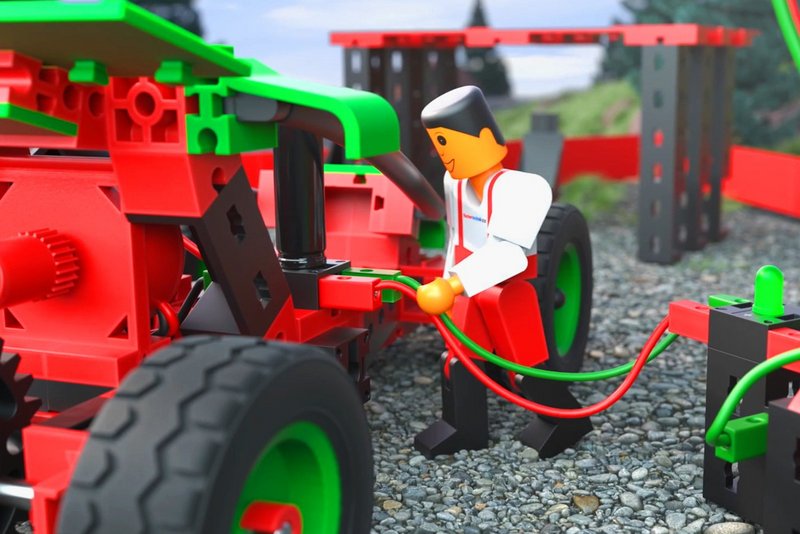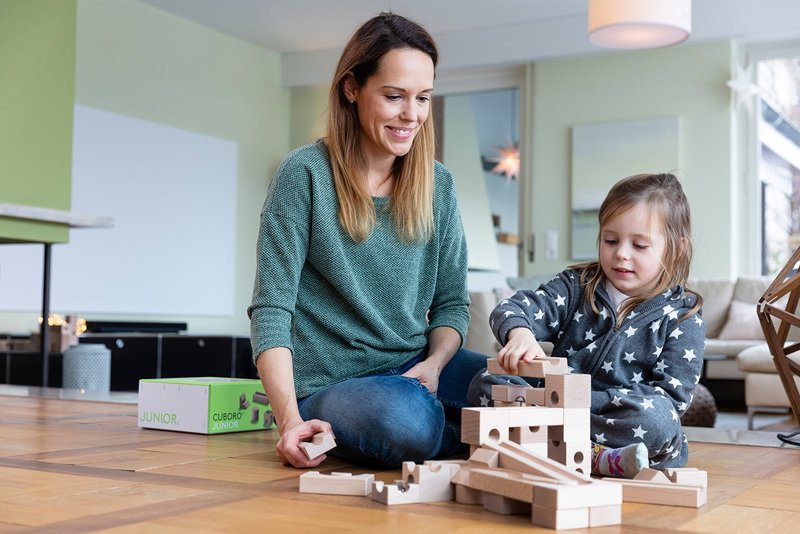
Ball tracks: with momentum into new dimensions of play
Electronic features are now complementing mechanical elements
by Peter Thomas
Once you give it a push, the marble, metal ball or model car whizzes along rails and tracks, propelled by gravity alone. These rolling play elements overcome loops and obstacles, while setting various mechanisms in motion – from the seesaw to the starting device of other components. This almost magical interlinking of different sequences is what makes ball tracks or marble runs so fascinating. However, the term for the game genre should be interpreted broadly, because besides the classic variants with balls made of different materials, there are also tracks based on similar principles with vehicles like Mattel’s Hot Wheels track for toy cars. A similar system used to be in the range of model-making manufacturer Faller (Hit Car).
Even on the international art scene, there are parallels to how ball tracks work when, in a creative chain reaction, new movement stimuli trigger the next attraction in a row, again and again. Probably the most famous example of this is the installation "The Way Things Go" by Fischli and Weiss from 1987. The course that designers of all ages can build with the Crazy Reactions construction set from Fischertechnik, presented in 2023, is similarly colourful and diverse. It starts with a particularly light ball: a table tennis ball.

One particularly popular material for building ball tracks is wood. The material is used for the classic marble run Cuboro from Switzerland, as well as with tracks from Ugears, whose laser-cut components are stuck together to make delicate, almost “skeletal” constructions. Colourfully printed wood is also the basis of the world of Kullerbü, the ball tracks from Haba. The system was launched onto the market in 2015, since when it has been continually added to. This year saw the premiere of the “Kullerhausen” play track construction set, among other things. The set combines the typical track elements (easy for children to use thanks to the click connections) and a playhouse with inhabitants. One special trick is that the Kullerbü figures have a rounded shape (diameter of 4.6 cm). This means they can be used on either the track or in the car – and thanks to a mechanical twisting effect, they then move, too. The vehicle fleet has been expanded with additional drive technologies (flywheel motor and battery-powered electronics).

Just what is the special attraction of building and playing with ball tracks and similar systems? I asked Wiebke Waburg, Vice Dean for Research at the University of Koblenz and professor of education with a focus on play and toy research. She says: “Just as with all construction games, if you want to build a marble run, you first have to come up with a plan in your head as to what the run should look like. Once you’ve achieved this plan and the marble run actually works, it triggers feelings of joy. Children and adults alike feel a sense of self-efficacy. The more complicated the track, the bigger the chance of failure – which is frustrating, but it also spurs us on to think about an alternative way of building it so that the next time we try it, it actually works. You could say it exerts a strong allure.”

The diversity of the materials and play options plays an important role, says Waburg, an educationalist: “Depending on the way the material for the ball track has been designed, this can also be an incentive to not only incorporate some fantastic effects, but also to build a beautiful and aesthetically pleasing track. This is where positive feedback, that is to say recognition, plays a role. The high appeal and fun of the game is further enhanced by the fact that there are usually many different design and building materials – depending on the game material. That’s also an important quality feature from an educational perspective.”
This variety also means that ball tracks can conquer new areas – by moving away from the classic track that is built on the table and the floor, for example. This is what the Gecko Run system from Kosmos can offer: its elements can be attached to smooth vertical surfaces using suction cups. Cupboard doors, for example, suddenly transform into a play area.

However, ball tracks have also long overstepped the boundary between the analogue-mechanical game and the electronic world. The Gravitrax system from Ravensburger is one example of this. Basically, the marble run works with magnetism, motion (kinetics) and gravity. The first sets were launched on the market in the autumn of 2017 and were promptly sold out by Christmas. The Gravitrax POWER line expands this world of play with the addition of light, sound and the option of programming the track via an app and digital exchange. In contrast, the new Gravitrax Junior line for children aged three and over has been on sale since 2023. With a special adapter set, it should be possible to connect to the existing railway system as of 2024.
Technical Toys at Spielwarenmesse 2024
Are your customers fascinated by ball tracks too? You’ll find the latest products for ball tracks and technical toys at the Spielwarenmesse in Nuremberg from 30 January to 3 February 2024. Find out more about the market and the manufacturers in Halls 4, 5 and 6.
Go to the product group Technical Toys, Educational Toys, Action Toys
About the Author:
Telling stories about technology and people: This has fascinated the journalist, author, cultural scientist and lecturer for more than 30 years. Technical toys are always in focus, from construction kits to interactive digital educational toys. After studying and working as a research assistant at university, Peter Thomas writes for daily newspapers, magazines and corporate publications in German and English-speaking countries. In addition to the world of games, his focus is on mobility, security, energy and medical technology.


![[Translate to Englisch:] [Translate to Englisch:]](/fileadmin/_processed_/1/1/csm_20230112_Teaser_ffd16edeed.jpg)

